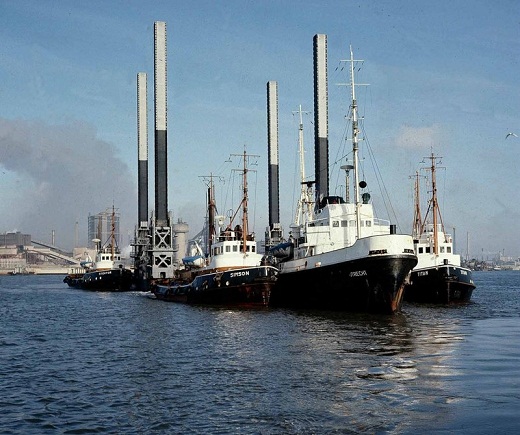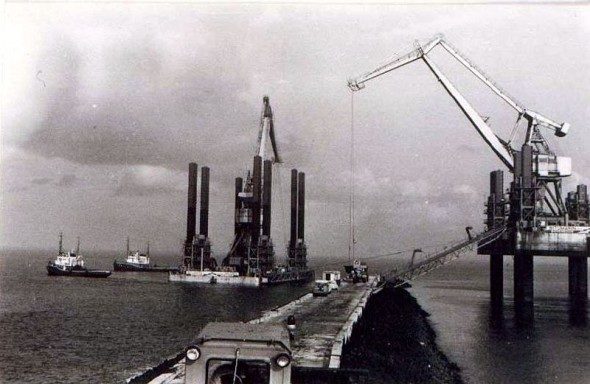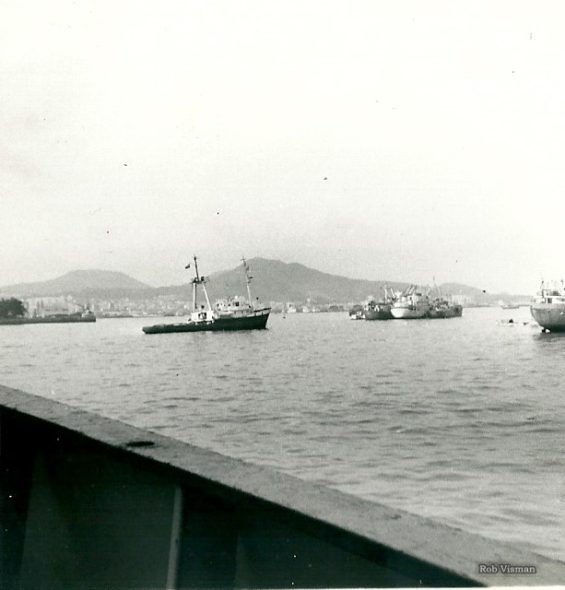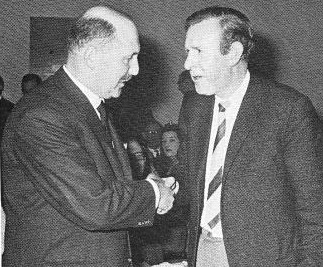…This is a story I copied from the valued site: www.bureauwijsmuller.nl
It is a good representation of how life on board of a ship took place, in which the captain has to weigh up his responsibility towards the ship, crew and tow, as seen through the eyes of an outsider.
The artist Reint de Jonge sailed with us as a guest on the ‘Utrecht’.
He came on board as a timid and pious man, but I have never seen a man change so quickly in two weeks.
Here is his story.
It was in the afternoon of 24 March that a remarkable transport left IJmuiden and set course for the open sea.
It was one of those strange and ingeniously thought out constructions, a floating island built by human hands, for which only one mode of transport is possible: they put a tugboat in front of it and they take away the stuff.
When she left, the huge inverted kitchen table passed by, because it looked like that, two related creations: the crane islands ‘Kraanvogel’ and ‘Lepelaar’.
The latter have already convincingly proven their soundness and all-weather qualities, one may as well hope so from the jack-up platform ‘Rio Parana’, which will be used for the construction of a car tunnel under the river of the same name.
This tunnel will form a link between the Argentine cities of Parana and Santa Fe.
I.H.C. Holland attaches its experiences, gained from the drilling rigs it built and the aforementioned crane islands, as a guarantee card to this cleverly constructed new fact, because tunnel construction using a lifting island like the ‘Rio Parana’, is a world first.
Strong currents and a significant tidal range in the river make the lowering of prefabricated tunnel segments a business that requires special facilities.
Well, with the almost 40 meter long and 30 meter wide jack-up island it is hoped that the 65 meter long tunnel sections can be accurately placed by a combination of 10 electrically driven winches.
The island has 4 legs of 64 meters length, the height of a respectable church tower.
These legs make it possible to bring the pontoon deck to 19 meters above the water surface.
The jack-up platform is equipped with the proven patented Gusto jack-up system.
There would be much more to say about the equipment and the working method, but we would like to pay particular attention to another facet of this project, namely transport.
It might be a good idea to make it clear that this is about a number of impressions of someone.
Someone whose hand stands more towards the brush than towards the nautically-technically driven pen.
It is good, when a marine painter-drawer regularly charges his inspiration batteries from practice.
It was Bureau Wijsmuller who gave your draughtsman the opportunity to do so.
Well, the weather conditions during the first part of this journey were such that there was no lack of practice.
There was a slight breeze when the tugboat ‘Utrecht’ steamed out its tug wire to a good 600 metres.
The island came along well and the speed was reasonably good.
Of the ‘Utrecht’ could be said that she sailed a generous crew.
Captains, helmsmen, drivers, cooks and accompanying sizes, they were present at least in duplicate, not to mention the Sparks occupation: of these officers there were no less than four on board, so that at this point a comfortable waiting arrangement was ensured.
Originally Falmouth was to be approached, where part of this overcrowding and the tow would be handed over to the ‘Willem Barendsz’.
Due to other activities Falmouth could not make it on time, so the ‘Utrecht’ changed its course southwards.
Initially the weather forecasts did not give much reason for gloomy reflections, but reality had another present waiting for us, which was unpacked at Brest.
The barometer dropped at the speed of a brick, while the wind quickly increased.
The horizon was obscured by showers, which came rolling over a grey-green sea like grey veils.
Dusty foam patterns hurled over the fast-acting waterbacks.
In a very short time the weather was from reasonably bad to very bad.
The speed went out and fell back to 2 miles.
Shortly thereafter a counter current of 3 miles was added, so it didn’t take long before we were put back.
‘What did we earn from that?’
Captain Oene Edelenbosch conjured up a Chesterfield from somewhere.
‘What to do with such a weather forecast’.
‘Who has matches?’
‘Are there no matches left on this ship?’
‘Do you have to see such a weather forecast?’
‘That’s where you’re under the coast!’
‘If you’re somewhere in space, it’s still possible, but now you’re driving that misery-Channel back in’.
‘What do you think, the wind catcher behind us wants it?’
Outside the storm whistled through the wiring.
The windcatcher was heavily in the sea and took over quite a lot of water.
With his short length he didn’t walk on, dived away in every hole and took everything with him.
Back to the front, into the bridge.
The Chesterfield is flipped in the ashtray.
It must happen: ‘We’re going around!’
‘Warn the engine room and let the boys prepare themselves for the back’.
‘What is the course now?’
‘225?’
‘Go to 230, we go around’.
High up the obtuse head of the ‘Utrecht’ points itself up, then it sinks down again and swing well through.
‘Five degrees to starboard!’
Slowly we cross the sea and listen to the water.
Crockery and ashtrays make it a real treat.
‘Go ahead but, five more, hold on!’
Work is being done on the back, it’s a water ballet with a dramatic impact.
One eye on the tow, which is now a bit more backward than right at starboard, one eye on the mooring line and the high sea.
The towing wire is stringed at an angle of 90° on the bumper rope.
‘To much strength for the bumper rope, it will break, away from there!’
It’s going and the towing wire is now immediately stiff from the betting at a right angle into the sea, pulls up and seems to be making plans to break it as well.
But that doesn’t happen.
Slowly we get around.
The man on the buck conjures up another Chesterfield and still has no matches.
Coffee is juggled up the bridge and the boys get a allowance of gin.
There we go with a generous 8 miles in front of the sea, but in the wrong direction.
Don’t float, but remember the wreckage-rich area we are sailing, steaming with a bunch without slack.
‘If it goes on like this, we can still be back in IJmuiden in time to see Dukla Prague – Ajax’.
We didn’t see Dukla Prague – Ajax, fortunately not and that wasn’t just because of Soetekouw!
Later in the evening the weather becomes a bit more manageable and without effort we turn around again.
When the next day the barometer drops again and the speed threatens to go out again, then the decision is made to go and look for a shelter under the shore.
That same evening we lie in Abraham’s lap, behind the island of Wight.
Wind and swell continue to make things difficult for us, even after we went back into the sea a day later, but as we get further south, both start to work to our advantage.
A constant speed of 6 to 7 miles can now be made and without shocking experiences we enter Las Palmas 15 days after departure from IJmuiden.
There we meet the ‘Willem Barendsz’.
Her skin shows all aspects of the rugged outdoor life and forms a beautiful range of Rembrandtesque tanning.
The ‘Rio Parana’ is detached from the tugboat ‘Utrecht’ and after a short time is stuck behind the ‘Willem Barendsz’.
There are some neighbourhood talks made, but there is not much time for that, because in the evening the ‘Willem Barendsz’ will leave for the last strong pull to Buenos Aires.
At 11 o’clock she steams outside and the last thing we see are 4 high towers, which slowly move along the traffic lights of Las Palmas.
A few hours later the tugboat ‘Utrecht’ follows, which sets course for Land’s End to move into its station position.
The next day one man left Las Palmas by plane to go home.
What he took with him?
These were drawings, photographs and memories.
Memories of a ship, of events and of people, with whom he felt very connected for two weeks.
In the hustle and bustle of the moment, he has been unable to say goodbye to most of them, but greets them all and wishes them a safe journey and a good watch.
Reint de Jonge
![]()





Leave a Reply